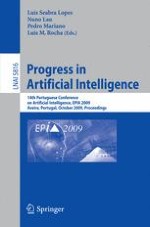This book contains a selection of higher quality and reviewed papers of the 14th Portuguese Conference on Artificial Intelligence, EPIA 2009, held in Aveiro, Portugal, in October 2009. The 55 revised full papers presented were carefully reviewed and selected from a total of 163 submissions. The papers are organized in topical sections on artificial intelligence in transportation and urban mobility (AITUM), artificial life and evolutionary algorithms (ALEA), computational methods in bioinformatics and systems biology (CMBSB), computational logic with applications (COLA), emotional and affective computing (EAC), general artificial intelligence (GAI), intelligent robotics (IROBOT), knowledge discovery and business intelligence (KDBI), muli-agent systems (MASTA) social simulation and modelling (SSM), text mining and application (TEMA) as well as web and network intelligence (WNI).
